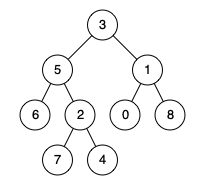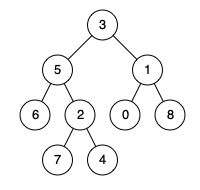Given two nodes of a binary tree p and q, return their lowest common ancestor (LCA).
Each node will have a reference to its parent node. The definition for Node is below:
class Node {
public int val;
public Node left;
public Node right;
public Node parent;
}
According to the definition of LCA on Wikipedia: “The lowest common ancestor of two nodes p and q in a tree T is the lowest node that has both p and q as descendants (where we allow a node to be a descendant of itself).”
Example 1:
Input: root = [3,5,1,6,2,0,8,null,null,7,4], p = 5, q = 1
Output: 3
Explanation: The LCA of nodes 5 and 1 is 3.

Example 2:
Input: root = [3,5,1,6,2,0,8,null,null,7,4], p = 5, q = 4
Output: 5
Explanation: The LCA of nodes 5 and 4 is 5 since a node can be a descendant of itself according to the LCA definition.

Example 3:
Input: root = [1,2], p = 1, q = 2
Output: 1
Constraints:
- The number of nodes in the tree is in the range [2, 105].
- -10^9 <= Node.val <= 10^9
- All Node.val are unique.
- p != q
- p and q exist in the tree.
/*
// Definition for a Node.
class Node {
public int val;
public Node left;
public Node right;
public Node parent;
};
*/
class Solution {
public Node lowestCommonAncestor(Node p, Node q) {
Node runner1 = p;
Node runner2 = q;
while (runner1 != runner2) {
runner1 = (runner1 == null) ? q: runner1.parent;
runner2 = (runner2 == null) ? p: runner2.parent;
}
return runner1;
}
/** DIFF HEIGTH APROACH **/
public Node lowestCommonAncestor2(Node p, Node q) {
int depth1 = depth(p);
int depth2 = depth(q);
if (depth1 < depth2) {
return lowestCommonAncestor(q, p);
}
int diff = depth1 - depth2;
while (diff > 0) {
p = p.parent;
diff--;
}
while (p != q) {
q = q.parent;
p = p.parent;
}
return p;
}
int depth(Node node) {
Node parent = node.parent;
int count = 0;
while (parent != null) {
parent = parent.parent;
count++;
}
return count;
}
/** HASH SET APPROACH */
public Node lowestCommonAncestor1(Node p, Node q) {
Set<Node> seen = new HashSet<Node>();
while (p != null) {
seen.add(p);
p = p.parent;
}
while (q != null) {
if (seen.contains(q)) {
return q;
}
q = q.parent;
}
return null;
}
}
Solution 2022-01-30
/*
// Definition for a Node.
class Node {
public int val;
public Node left;
public Node right;
public Node parent;
};
*/
class Solution {
public Node lowestCommonAncestor(Node p, Node q) {
Node s = p;
Node f = q;
while (s != f) {
s = s.parent;
f = f.parent;
if (s == null) {
s = p;
}
if (f == null) {
f = q;
}
}
return s;
}
}